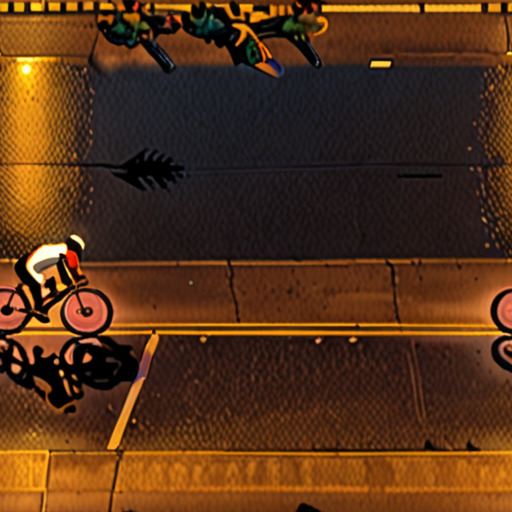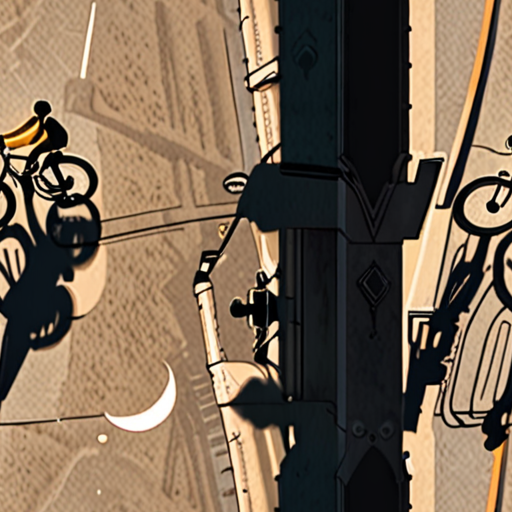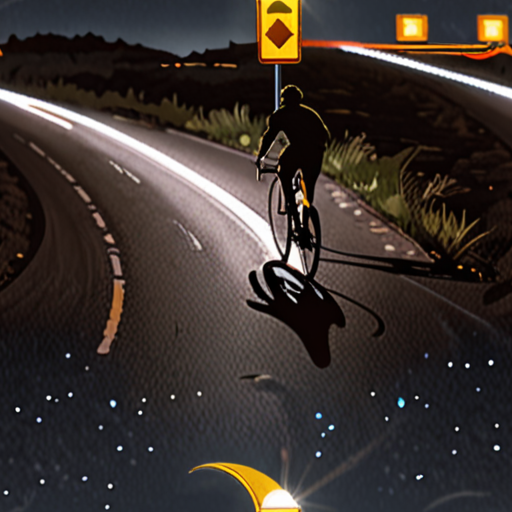As the sun sets and the stars begin to twinkle in the night sky, many cyclists face a daunting challenge: navigating the roads safely after dark. Whether you’re a seasoned pro or a casual rider, cycling at night can be intimidating, especially if you’re unsure about how to stay visible and alert on the road. In this comprehensive guide, we’ll delve into the world of night cycling, exploring essential gear, safety tips, and expert advice to help you ride with confidence under the stars.

Staying Safe While Cycling at Night
Cycling at night can be intimidating, but with the right precautions and knowledge, you can minimize risks and enjoy a safe ride.
- Wear Reflective Gear
- Use Front and Rear Lights
- Ride Defensively
- Follow Traffic Rules
- Check Your Bike
- Stay Visible on Intersections
- Be Aware of Weather Conditions
- Carry a Basic Toolkit
- Let Someone Know Your Route
- Stay Alert and Focused
Make yourself visible to drivers by wearing reflective clothing, arm bands, and ankle straps. These accessories can be found at most cycling stores or online.
A well-lit bike is essential for nighttime riding. Invest in high-quality front and rear lights that are visible from a distance. Consider LED lights, which are energy-efficient and long-lasting.
Anticipate potential hazards and ride defensively. Stay alert and aware of your surroundings, including pedestrians, cars, and other cyclists.
Familiarize yourself with local traffic laws and regulations. Obey traffic signals, stop signs, and pedestrian crossings to avoid accidents.
Before embarking on a nighttime ride, ensure your bike is in good working condition. Check tire pressure, brakes, and lights to prevent mechanical issues.
When approaching intersections, increase your visibility by using hand signals and making eye contact with drivers. This helps prevent misunderstandings and reduces the risk of collisions.
Weather conditions can significantly impact your safety while cycling at night. Be cautious of rain, fog, or strong winds, which can reduce visibility and increase the risk of accidents.
In case of a flat tire or other mechanical issue, carry a basic toolkit containing essentials like a pump, spare tube, and multi-tool.
Inform a friend or family member of your planned route and estimated return time. This ensures someone knows your whereabouts in case of an emergency.
Maintain your concentration and stay alert during the ride. Avoid distractions like using your phone or listening to music, which can compromise your safety.
By following these guidelines, you’ll be better equipped to handle the challenges of nighttime cycling and enjoy a safer, more enjoyable ride.
The 75 Rule in Cycling
The 75 rule in cycling refers to a simple yet effective technique for determining whether a rider is going too fast for their fitness level.
- This rule states that a rider should not exceed 75% of their maximum heart rate during a ride.
- To calculate your maximum heart rate, subtract your age from 220.
- For example, if you’re 30 years old, your maximum heart rate would be 190 beats per minute (220 – 30 = 190).
- Then, multiply this number by 0.75 to find your target heart rate zone.
- In our example, this would be 142.5 beats per minute (190 x 0.75 = 142.5).
- Aiming to stay within this zone can help prevent burnout and reduce the risk of injury.
- Additionally, the 75 rule can be applied to other aspects of cycling, such as power output and cadence.
- By monitoring these factors and staying within the recommended ranges, riders can optimize their performance and enjoy a safer, more enjoyable ride.
At Leeds Bicycle, we recommend incorporating the 75 rule into your training routine to take your cycling to the next level.
Remember to always listen to your body and adjust your intensity accordingly.
With consistent practice and patience, you’ll be able to push yourself safely and effectively, achieving your goals and enjoying the many benefits of cycling.

Riding a Bicycle at Night: Essential Safety Tips
As a cyclist, I always emphasize the importance of safety, especially when riding at night.
- Wear Reflective Gear
- Use Front and Rear Lights
- Check Your Bike Before Riding
- Ride Defensively
- Stay Alert and Focused
- Follow Local Traffic Laws
- Be Visible to Motorists
- Have a Basic Tool Kit
- Let Someone Know Your Route
I recommend wearing reflective clothing, such as jackets or arm bands, to increase visibility to motorists.
A well-lit bike is essential for safe nighttime riding. Make sure to use front and rear lights that meet local regulations.
Before embarking on a nighttime ride, inspect your bike to ensure that the brakes, tires, and lights are in good working condition.
Anticipate the actions of motorists and pedestrians, and be prepared to react accordingly.
Avoid distractions, such as using your phone or listening to music, and stay focused on the road ahead.
Familiarize yourself with local traffic laws and regulations regarding nighttime cycling.
Make eye contact with motorists and use hand signals to indicate your intentions.
Carry a basic tool kit, including a spare tube, tire levers, and a pump, in case of emergencies.
Inform a friend or family member of your planned route and estimated return time.
By following these essential safety tips, you can enjoy a safe and enjoyable nighttime cycling experience.

Is it OK to do cycling at night?
Riding at night can be a great option for those who enjoy cycling, as it offers a unique perspective and can be safer due to fewer cars on the road.
- One of the primary advantages of nighttime cycling is reduced traffic congestion, making it easier to navigate roads and bike paths.
- Additionally, wearing proper lighting and reflective gear can increase visibility, reducing the risk of accidents.
- However, it’s essential to exercise caution and follow safety guidelines, such as wearing bright clothing, using front and rear lights, and being aware of potential hazards like potholes and debris.
As a cyclist, it’s crucial to stay alert and focused, especially in low-light conditions. Here are some tips to enhance your nighttime cycling experience:
- Invest in high-quality lights and reflectors to increase visibility.
- Wear bright and reflective clothing to make yourself more noticeable to drivers.
- Stay hydrated and energized with snacks and water to maintain your energy levels.
- Avoid riding in areas with poor lighting or heavy pedestrian traffic.
At Leeds Bicycle, we recommend checking local regulations and guidelines before embarking on a nighttime ride. It’s also a good idea to inform friends or family members of your route and expected return time.
By taking necessary precautions and staying vigilant, you can enjoy a safe and enjoyable nighttime cycling experience.
For more information on cycling safety and best practices, visit our cycling safety tips page.
Remember to always wear a helmet and follow local traffic laws to ensure a safe and enjoyable ride.
Visit our bike maintenance guides for tips on how to keep your bike in top condition.
For more information on cycling routes and trails in your area, check out our cycling routes and trails page.
Is Biking Alone at Night Safe?
Biking at night can be a daunting experience, especially when riding alone.
- Reduced visibility due to darkness and potential glare from headlights
- Impaired drivers who may have difficulty seeing cyclists
- Dangerous intersections and road conditions
- Potential for bike theft or vandalism
Precautions to Take
To minimize risks, consider the following precautions:
- Wear bright and reflective clothing to increase visibility
- Install front and rear lights on your bicycle to enhance visibility
- Ride defensively and anticipate the actions of motorists
- Avoid riding in areas with poor lighting or heavy pedestrian traffic
- Consider investing in a bike helmet with built-in lights or reflectors
Staying Safe While Riding at Night
At Leeds Bicycle, we recommend taking extra precautions when riding at night:
- Stay alert and focused on the road ahead
- Avoid distractions such as using your phone or listening to music
- Keep your bike in good working condition, with properly functioning brakes and tires
- Be mindful of your surroundings and keep an eye out for potential hazards
Additional Tips
For added peace of mind, consider the following:
- Tell a friend or family member your route and estimated return time
- Carry a basic tool kit and spare tube in case of emergencies
- Keep your bike locked securely when parked, using a U-lock or chain lock
- Consider joining a local cycling group or club for added safety and camaraderie
Conclusion is Not Needed

Which Time of Day is Riskiest for Cyclists?
Nearly one-third of bicycle crashes with motor vehicles happen between 6:00 pm and 6:00 am.
- Ride in well-lit areas whenever possible
- Wear bright and reflective clothing
- Add reflectors and a front light to your bike
Inclement weather poses many dangers to bicyclists, making it essential to check the forecast before embarking on a ride.
According to various studies, the most hazardous times for cyclists are during rush hour, early morning, and late evening commutes.
As a cyclist, it’s crucial to stay alert and aware of your surroundings, especially during these high-risk periods.
Additionally, consider investing in safety gear such as helmets, knee pads, and elbow guards to minimize the impact of potential accidents.
By taking these precautions and staying informed, you can significantly reduce your risk of being involved in a cycling accident.
At Leeds Bicycle, we emphasize the importance of road safety and encourage our community to share their experiences and tips for staying safe on the roads.
Visit our website for more information on cycling safety and to learn how to navigate challenging road conditions.
Cycling Safety Tips:
- Always wear a helmet and follow local laws regarding helmet usage
- Be visible and use lights or reflectors when riding in low-light conditions
- Avoid distractions while riding, such as using your phone or listening to music
- Follow traffic rules and signals, and always yield to pedestrians and other vehicles
Conclusion:
By understanding the risks associated with certain times of day and taking necessary precautions, cyclists can significantly reduce their chances of being involved in an accident.
Remember to stay vigilant, follow safety guidelines, and enjoy the benefits of cycling while minimizing the risks.

0 Comments